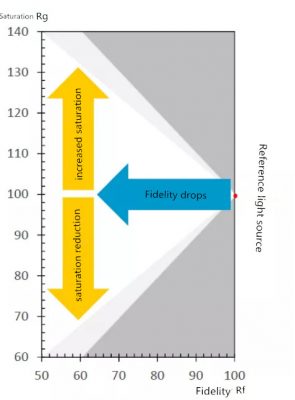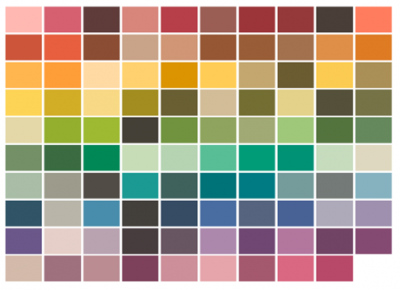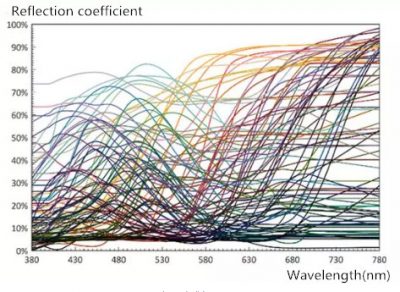On 9th ,October, 2018, the Illuminating Engineering Society of North America (IES) released a new version of the light source color quality evaluation standard – IES TM-30-18 Method for Evaluating Light Source Color Rendition (evaluation of light source color reproduction method), with a partial update to the legacy documentation.
Compared with the old version of the document released in 2015, the TM-30-18 version has modified the following three points:
• Adjusted spectral reflectance calculation function for swatches in the range of less than 400 nm and greater than 700 nm.
• Adjusted the transition area of the reference light source, the applicable color temperature range has changed from 4500K-5500K to 4000K-5000K.
• Modified the evaluation formula of color fidelity Rf, the calculated scale factor was changed from 7.54 to 6.73.
In April 2017, the International Commission on Illumination (CIE) released a technical report “CIE 224: 2017 Colour Fidelity Index for accurate scientific use”, which defines the color fidelity index Rf. This index is calculated based on the Fidelity Index in IES TM-30-15, but there are minor differences in the extrapolation used for color evaluation samples, the transition area of the reference illuminant, and the scale factor for fidelity calculations. The two documents were harmonized with the release of TM-30-18, an important step in the globalization of color fidelity measurement.
For a long time, the general color rendering index Ra used by CIE to evaluate color quality has been widely used to describe the visual experience of various light source technologies. However, IES believes that Ra only considers one aspect of color quality, cannot fully express the human eye’s perception of color, cannot establish the integrity of the visual experience, and is defective in accurately reproducing the color of the light source. To this end, IES established a Color Metrics Task Group (IES Color Metrics Task Group) in March 2013 to study improvement measures to characterize the color rendering of light sources in order to develop a system to replace CRI and better serve the lighting industry and its stakeholders. On 18th, May, 2015, IES officially released the normative document IES TM-30-15 for evaluating the color rendering of light sources, using two color fidelity index Rf (Fidelity Index) and color saturation index Rg (Gamut Index). Indicators are used to jointly evaluate color quality, which is significantly different from CIE’s CRI system.
Compared with the original color rendering index evaluation system of CIE, the evaluation method of IES TM-30 has the following five major changes:
1. Dual-index evaluation system

Color Fidelity Rf and Color Saturation Rg of IES TM-30
TM-30 uses two indicators, Fidelity Rf and Saturation Rg, to jointly evaluate color quality. Fidelity Rf is used to characterize the color rendering index CRI (Color Rendering Index) of the light source. The similarity of each standard color under the illumination of the test light source compared with that under the illumination of the reference light source. The number ranges from 0 to 100, and the higher the value, the better color of the authenticity will be. This metric is similar to the CIE13.3-1995 general color rendering index Ra when evaluating CRI, both to characterize the average color fidelity, but the TM-30 uses 99 completely new color samples and a newly developed calculation method. IES believes that Rf can provide more statistically representative and reliable data, and will be more accurate in color reproduction.
• Rf =100 is the maximum value, which means there is no color difference with the natural light source, and the color effect is realistic.
• Rf = 0 is the minimum value, which means that the color difference from the natural light source is the largest, and the color effect is distorted.
The color saturation Rg is used to characterize the color gamut index GAI (Gamut Area Index) of the light source. That is, the degree of saturation of each standard color compared with the reference light source under the illumination of the test light source. An index of 100 represents the best saturation.
• Rg =100, which means that the saturation of the light source is the same as that of natural light, and the color saturation is moderate.
• Rg>100, which means that the light source can increase the saturation of the color, and the object looks more vivid and vibrant.
• Rg<100, which means that the saturation of the color will decrease under the test light source, the color saturation will be insufficient, and the object will become dull and dull.
2. More and more realistic standard colors

99 standard colors used in IES TM-30
CIE’s Ra selected 8 Munsell color palettes as standard colors. These colors have medium lightness and color saturation, which can fully represent the common colors of indoor lighting, but have high saturation for outdoor lighting. The colors are not representative. Since the colors used are not sufficient to represent all visible wavelengths, luminaire manufacturers can optimize the spectral power distribution (SPD) of their light sources for higher measurement values.

Spectral reflectance distribution curves of 99 standard colors in IES TM-30
Compared with Ra’s only 8 standard swatches, the TM-30 system uses as many as 99 standard swatches. These swatches are no longer Munsell swatches, but selected from 105,000 real object colors. Including natural objects, skin tones, textiles, paints, plastics, printed materials, color systems and other 7 categories, representing a variety of saturated to unsaturated, bright to dark colors that are common in our lives. Most importantly, these 99 standard colors have the same sensitivity for each wavelength, so it is difficult for manufacturers to adjust the spectral distribution to improve the measurement value.
TM-30 gives the calculation function of spectral reflectance of different color plate samples and the calculation formula and guidance of Rf and Rg values, and the measurement results can be calculated through an auxiliary software.
3. Choose a more reasonable reference light source

Reference light source diagram
Since the reference light source used by CRI uses black body radiation when it is lower than 5000K, and uses the natural light model when it is higher than 5000K, there is a sudden change of 5000K. The TM-30 system uses a spectrum of blackbody radiation mixed with a natural light model as a reference light source in the range of 4000K-5000K. In addition, both Rf and Rg use a reference light source with the same color temperature as the light source to be measured, thereby overcoming an important drawback of GAI.
4. Use a more uniform chromaticity space
The TM-30 uses the modern color space CAM02-UCS (CIE Color Appearance Model 02) with improved uniformity and more accurate color adaptation equations, as well as an optimized set of color samples representing real objects.
5. Added color vector graphics
Since the fidelity and saturation indices are calculated based on the average value, only the average color rendering ability of the light source for various colors can be comprehensively evaluated, and the saturation degree of a certain color cannot be judged accordingly. When there is a need for the color rendering ability of some specific colors, the TM-30 system also provides a Color Vector Graphic, which directly displays the color shift and saturation of a specific color under the measured light source with graphics. Whether the change is dim or more vivid is a great addition to the Fidelity and Saturation Index.

IES TM-30 can provide more intuitive represents the color shift and saturation changes of various colors changed Color Distortion Icons
The black circle represents the reference light source (sunlight), which consists of 16 color classifications of the reference light source, and the red circle represents the measured light source. Any red line inside the black circle indicates that these colors of the illuminant under test are dimmer compared to the reference illuminant, and any red line outside the black circle indicates that these colors of the illuminant under test are oversaturated compared to the reference illuminant. When the red and black circles are perfectly overlapped, it means that these colors of the measured light source and the reference light source are the same, and there is no difference in color rendering between the two light sources.
IES recognizes that color specifications depend on a variety of conditions, including but not limited to factors such as visual needs, interaction with furniture and decorative materials, age and color preferences. Therefore, IES recommends that lighting professionals use the more accurate and complete color reproduction evaluation method IES TM-30-18, refer to a variety of measurement methods in the standard, and formulate applicable specifications based on various spectral and application characteristics to achieve the fastest transition.

IES TM-30-18 Color Rendition test report
Lisun Instruments Limited was found by LISUN GROUP in 2003. LISUN quality system has been strictly certified by ISO9001:2015. As a CIE Membership, LISUN products are designed based on CIE, IEC and other international or national standards. All products passed CE certificate and authenticated by the third party lab.
Our main products are Goniophotometer, Integrating Sphere, Spectroradiometer, Surge Generator, ESD Simulator, EMI Receiver, EMC Test Equipment, Electrical Safety Tester, Environmental Chamber, Temperature Chamber, Climate Chamber, Thermal Chamber, Salt Spray Test, Dust Test Chamber, Waterproof Test, RoHS Test (EDXRF), Glow Wire Test and Needle Flame Test.
Please feel free to contact us if you need any support.
Tech Dep: Service@Lisungroup.com, Cell/WhatsApp:+8615317907381
Sales Dep: Sales@Lisungroup.com, Cell/WhatsApp:+8618917996096
Your email address will not be published. Required fields are marked *